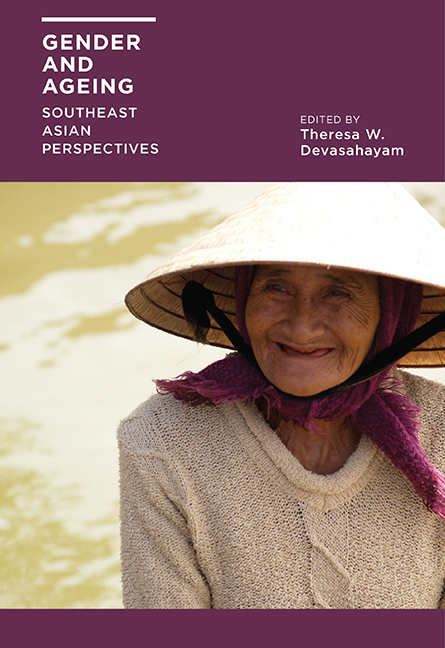Book contents
- Frontmatter
- Contents
- List of Tables and Figures
- Acknowledgments
- Contributors
- 1 Growing Old in Southeast Asia: What Do We Know about Gender?
- 2 Gender and Ageing in Thailand: A Situation Analysis of Older Women and Men
- 3 Gender and Well-being of Older Persons in Cambodia
- 4 Preparations for Old Age and Social Participation of Present and Future Older Persons in Thailand: Gender Difference
- 5 Gender and Health Status among Older Adults in Vietnam
- 6 Ageing and Gender Preferences in Rural Indonesia
- 7 Exploring the Experiences of Older Men and Women in Caregiving and Care-receiving in Sarawak, Malaysia
- 8 An “Active Ageing” Approach to Living Alone: Older Men and Women Living in Rental Flats in Singapore
- 9 Ethnic Patterns and Styles of Active Ageing among Widows and Widowers in Singapore
- 10 Employment Patterns of Older Women in Indonesia
- 11 Gender Differentials in Work and Income among Older Malaysians
- 12 Gender and Economic Well-being among Older Filipinos
- 13 Work, Retirement and the Gender Divide in the Philippines
- Index
3 - Gender and Well-being of Older Persons in Cambodia
Published online by Cambridge University Press: 21 October 2015
- Frontmatter
- Contents
- List of Tables and Figures
- Acknowledgments
- Contributors
- 1 Growing Old in Southeast Asia: What Do We Know about Gender?
- 2 Gender and Ageing in Thailand: A Situation Analysis of Older Women and Men
- 3 Gender and Well-being of Older Persons in Cambodia
- 4 Preparations for Old Age and Social Participation of Present and Future Older Persons in Thailand: Gender Difference
- 5 Gender and Health Status among Older Adults in Vietnam
- 6 Ageing and Gender Preferences in Rural Indonesia
- 7 Exploring the Experiences of Older Men and Women in Caregiving and Care-receiving in Sarawak, Malaysia
- 8 An “Active Ageing” Approach to Living Alone: Older Men and Women Living in Rental Flats in Singapore
- 9 Ethnic Patterns and Styles of Active Ageing among Widows and Widowers in Singapore
- 10 Employment Patterns of Older Women in Indonesia
- 11 Gender Differentials in Work and Income among Older Malaysians
- 12 Gender and Economic Well-being among Older Filipinos
- 13 Work, Retirement and the Gender Divide in the Philippines
- Index
Summary
INTRODUCTION
Today's population of older Cambodians lived through an exceptionally traumatic period of history during their adult years. Prolonged civil strife starting in the 1960s eventually led to the complete take over of the country by the brutal Khmer Rouge regime in 1975. During their fouryear rule, political violence, severe food shortages, and lack of medical care resulted in the deaths of as much as a fourth of the population (Heuveline 1998). Many who died were the children or spouses of today's older-aged population. Social dislocation, continuing political conflict, pervasive poverty, and an AIDS epidemic took their toll during the succeeding years resulting in further losses of family members. These events potentially threaten the core family support of older persons in a country that is among the poorest in Asia and where formal channels of assistance are minimal (Knodel 2007; Zimmer et al. 2006).
Population ageing is at an early stage in Cambodia with less than 6 per cent of the current total population being 60 or older, the lowest proportion of elderly of all the countries in Southeast Asia (Mujahid 2006). The low proportion of elderly in the population has resulted in the general lack of attention to issues related to older persons by the Cambodian government and most international agencies. Nevertheless, over one in four households or around 27 per cent has at least one member who is 60 or older. With recent prodding by UNFPA and HelpAge International, ageing is beginning to emerge as an issue on the government's agenda, although efforts are modest and mostly appear to be in the planning stages (Office of the Council of Ministers 2007; UNESCAP 2007).
Gender issues in general have received some attention in Cambodia, although the focus almost exclusively concerns the interests of women. Again this is in part, if not in the main, in response to the prompting and support of international agencies (UNIFEM et al. 2004; UNDP Cambodia 2008).
- Type
- Chapter
- Information
- Gender and AgeingSoutheast Asian Perspectives, pp. 68 - 98Publisher: ISEAS–Yusof Ishak InstitutePrint publication year: 2014

